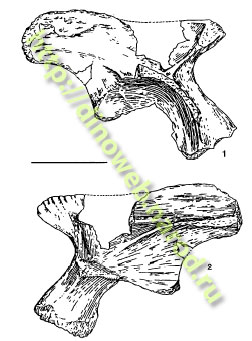
Complete Data Base of Paleozoic and Mesozoic Tetrapods.
Paleo-News and illustrations. Big electronic PDF-library.
| |
| PaleoNews |
| Classification |
| Books and Articles |
| Contact |
| Forum |
сайт о динозаврах
рейтинг сайтов
Free Counter
myspace hit counter
Caseosaurus |
Genus: Caseosaurus Hunt, Lucas, Heckert , Sullivan , and Lockley, 1998 Classification: Dinosauria - Saurischia - Theropoda - Herrerasauria Etymology: In recognition of E. C. Case who discovered the holotype and made substantial contributions to our knowledge of late Triassic tetrapods. Synonyms: none Type species: Hunt, Lucas, Heckert , Sullivan , and Lockley, 1998 Other Species: none Diagnosis: Species: C. crosbyensis Hunt, Lucas, Heckert , Sullivan , and Lockley, 1998 Etymology: In reference to Crosby County, Texas which yielded the holotype Synonyms: Holotype: UMMP 8870: Right ilium. Referred Specimens: = cf. Caseosaurus crosbyensis Nesbitt, Irmis, and Parker, 2007 Time: Carnian, Late Triassic. Horizon: Tecovas Member, Dockum Formation. Location: Crosby County, exact locality unknown, Texas, USA. Total length: Mass: Diagnosis: Herrerasaur whose ilium differs from Staurikosaurus and Herrerasaurus in possessing: (1) an elongate and dorsoventrally narrow posterior blade; (2) a narrow ridge on the l a t e r a l margin that extends from the anterodorsal margin of the acetabulum to the anterodorsal anterior spine; (3) a highly reduced brevis fossa; and (4) a semicircular margin dorsal to the acetabulum; differs from Chindesaurus bryansmalli in possessing a less deep brevis shelf which does not extend to the posterior margin, a l a t e r a l longitudinal ridge (for sacral rib a r t i c u l a t i o n ) which is placed more ventrally and a much thinner (less than half) posterior blade in dorsal view (Hunt, Lucas, Heckert, Sullivan & Lockley, 1998). Comments: Case (1927) described an isolated dinosaur ilium (UMMP 8870) from the Tecovas Member that Long assigned to the herrerasaurid Chindesaurus bryansmalli. This specimen bears a strong resemblance to the corresponding element in Staurikosaurus and Herrerasaurus in being anteroposteriorly short and dorsoventrally high with a partially perforate acetabulum. Specifically, UMMP 8870 represents a dinosaur because it has a brevis shelf and a medially opened acetabular wall. Further, it represents a herrerasaur because the brevis shelf is reduced to a slight ridge, and the brevis fossa is small. UMMP 8870 differs from Staurikosaurus and Herrerasaurus in possessing: (1) an elongate and dorsoventrally narrow posterior blade; (2) a narrow ridge on the lateral margin that extends from the anterodorsal margin of the acetabulum to the anterodorsal anterior spine; (3) a highly reduced brevis fossa; and (4) a semicircular margin dorsal to the acetabulum. Long (in Murry, 1989; Long & Murry 1995) assigned UMMP 8870 to Chindesaurus bryansmalli. The holotype of Chindesaurus (PEFO 10395) includes only two small fragments of the ilium, that Long and Murry (1995) consider to be indistinguishable from UMMP 8870 - a fragment of the pubic process of the left ilium and a portion of the left posterior iliac blade. Illustrations: Holotype ilium of Caseosaurus crosbyensis (UMMP 8870) in lateral (1) and medial (2) views (after Case 1927). Scale bar is 5 cm. References: Long, R. A., and Murry P. A., 1995, Late Triassic (Carnian and Norian) Tetrapods from the Southwestern United States: New Mexico Museum of Natural History & Science, A Division of the Office of Cultural Affairs, Bulletin 4, p. 1-254. Hunt, A. P., Lucas S. G., Heckert A. B., Sullivan R. M., and Lockley M. G., 1998, Late Triassic Dinosaurs from the Western United States: Geobios, v. 31, n. 4, p. 511-531. Nesbitt, S. J., Irmis, R. B., and Parker, W. G., 2007, A critical re-evaluation of the Late Triassic Dinosaur Taxa of North America: Journal of Systematic Palaeontology, v. 5, n. 2, p. 209-243. © Tetrapoda Database Roman Ulansky roman.ulansky@gmail.com or adios85@mail.ru
|

